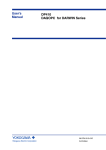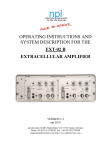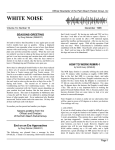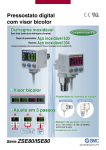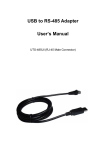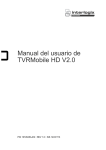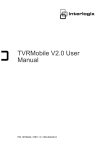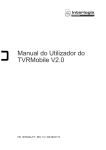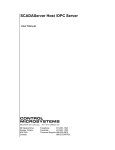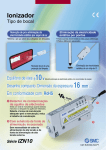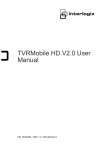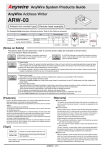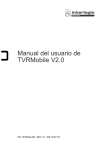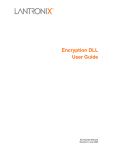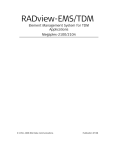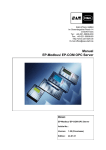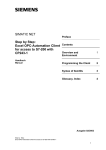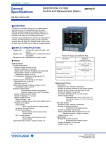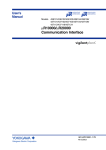Download DXA410 DAQOPC User`s Manual
Transcript
User's Manual DXA410 DAQOPC User's Manual IM 04L01B03-61E Yokogawa Electric Corporation 5th Edition Foreword This manual explains the functions and operations of DAQOPC. To ensure correct use, please read this manual thoroughly before beginning operation. After reading the manual, keep it in a convenient location for quick reference whenever a question arises during operation. DAQOPC is an OPC server that provides OPC interface (Data Access interface). The OPC interface was designed by the OPC (OLE for Processing Control) Foundation. This manual describes the specifications of the Data Access interface and venderspecific section. This manual is for those who understand the specifications of the OPC Foundation. Notes • The contents of this manual are subject to change without prior notice as a result of continuing improvements to the instrument’s performance and functions. • Every effort has been made in the preparation of this manual to ensure the accuracy of its contents. However, should you have any questions or find any errors, please contact your nearest YOKOGAWA dealer as listed on the back cover of this manual. • Copying or reproducing all or any part of the contents of this manual without the permission of Yokogawa Electric Corporation is strictly prohibited. Copyright • YOKOGAWA holds the copyright to the software that is on the CD-R. Trademarks • All the brands or names of Yokogawa Electric’s products used in this manual are either trademarks or registered trademarks of Yokogawa Electric Corporation. • Microsoft, MS-DOS, Windows, Windows 2000, and Windows NT are either registered trademarks or trademarks of Microsoft Corporation in the United States and/or other countries. • Adobe and Adobe Acrobat are trademarks of Adobe Systems Incorporated (Adobe Systems). • Other company and product names are trademarks or registered trademarks of their respective companies. • For purposes of this manual, the and symbols do not accompany their respective trademark names or registered trademark names. Revisions 1st Edition 2nd Edition 3rd Edition 4th Edition 5th Edition November 2000 September 2001 May 2002 November 2002 December 2005 5th Edition: December 2005 (YK) All Rights Reserved, Copyright © 2000 Yokogawa Electric Corporation IM 04L01B03-61E i Checking the Contents of the Package Unpack the box and check the contents before operating the software. If some items are missing or otherwise inconsistent with the contents description, please contact your dealer or nearest YOKOGAWA representative. Model and Suffix Code Model Basic Suffix Code DXA410 Specification DAQOPC OPC Server -0 OS (Windows NT Workstation 4.0,NT Server 4.0,Windows 2000) 1 2 3 4 Basic Version, Japanese Basic Version, English Advanced Version, Japanese Advanced Version, English Package Contents DXA410 DAQOPC User's manual (this document) DXA410 DAQOPC Installation manual ii 1 pc. CD-R 1 pc. (in case) 1 pc. IM 04L01B03-61E Notes on Using This Product Storing the CD-R Please store the original CD-R in a safe place. During the actual operation, use the software that is installed on the hard disk. Agreement Restriction on Use Use of this product (this utility software and manual) by more than one computer at the same time is prohibited. Use by more than one user is also prohibited. Transfer and Lending Transfer or lending of this product to any third party is prohibited. Guarantee Should a physical deficiency be found on the original CD-R or this manual upon opening the product package, please promptly inform Yokogawa. The claim must be made within seven days from the date you received the product in order to receive a replacement free of charge. Exemption from Responsibility Yokogawa Electric Corporation provides no guarantees other than for physical deficiencies found on the original CD-R or this manual upon opening the product package. Yokogawa Electric Corporation shall not be held responsible by any party for any losses or damage, direct or indirect, caused by the use or any unpredictable defect of the product. Copyright YOKOGAWA holds the copyright to the software that is on the CD-R. IM 04L01B03-61E iii CD-R Handling Guidelines Make sure to take the following safety precautions. Caution • Do not store the product near large amounts of refuse or dust. • Do not touch the side of the CD-R with no printed characters. Dirt or sweat from fingertips can damage the CD-R. Do not write anything on the CD-R. • Pencil lead or residue from erasers can damage the CD-R. • Do not bend or scratch the CD-R. Doing so can cause it to become unreadable. • Never place anything on top of the CD-R. Doing so can cause deformities that can render the CD-R useless. • Do not drop the CD-R from high locations. Dropping the CD-R can cause damage or deformities. • Do not place the CD-R in direct sunlight or near heat sources. • When cleaning the CD-R, do not use solvents. Especially do not use alcohol, benzene, or freon. • Take care when placing the CD-R into the CD-ROM drive. • While the CD-R is being accessed, do not remove the CD-R from the CD-ROM drive, cut the power to the PC, or reset the computer. • Store the CD-R in its original jewel case. Do not leave the CD-R in the CD-ROM drive after use. It can become deformed or damaged unless it is kept in its case. iv IM 04L01B03-61E 1 Contents Checking the Contents of the Package ........................................................................................... ii Notes on Using This Product .......................................................................................................... iii CD-R Handling Guidelines ............................................................................................................. iv Chapter 1 Overview 1.1 1.2 1.3 Functional Overview of DAQOPC .................................................................................... 1-1 Overall Configuration and DAQOPC Interface ................................................................. 1-6 Server Function ................................................................................................................ 1-7 2 3 Index Chapter 2 DAQOPC Operation 2.1 2.2 2.3 2.4 Flow of DAQOPC Operation ............................................................................................ 2-1 Starting the Configurator and Setting Parameters ........................................................... 2-2 Starting and Stopping DAQOPC ...................................................................................... 2-9 Setting Up the DAQOPC Client ..................................................................................... 2-10 Chapter 3 DAQOPC DA Server Functions 3.1 3.2 3.3 Overview of the DAQOPC DA Server Function ............................................................... 3-1 Data Access Method via the OPC Interface .................................................................. 3-1 OPC Interface Compliance ............................................................................................ 3-1 OPC Interface Functions .................................................................................................. 3-2 3.2.1 A List of Interfaces .............................................................................................. 3-2 3.2.2 Process Data ...................................................................................................... 3-7 3.2.3 ItemID ............................................................................................................... 3-10 Defining the ItemID ........................................................................................... 3-10 A list of ItemIDs ................................................................................................ 3-10 Item IDs ............................................................................................................ 3-12 Access path ...................................................................................................... 3-17 Blob .................................................................................................................. 3-17 3.2.4 Data acquisition operation ................................................................................ 3-18 Limits of Data Acquisition Operation ................................................................ 3-18 Cached data update ......................................................................................... 3-18 Data change notification ................................................................................... 3-19 3.2.5 Group Object Properties (IOPCGroupStateMgt) .............................................. 3-19 3.2.6 Item Properties ................................................................................................. 3-20 3.2.7 Locale ID (LCID) ............................................................................................... 3-44 3.2.8 Structures Defined by the OPC ........................................................................ 3-44 3.2.9 Support for OPC Optional Specifications ......................................................... 3-45 Error Codes .................................................................................................................... 3-46 Index IM 04L01B03-61E v Chapter 1 Overview 1.1 1 Functional Overview of DAQOPC Overview What Is an OPC Interface By using the OPC interface provided by YOKOGAWA, the user is able to access various data on the DX/DX-P/MV/CX via the DAQOPC server using an OPC-compliant application that runs on a Windows machine. The user does not have to create a special application program. The OPC interface is a standard interface that uses OLE (Object Linking and Embedding) for process control. It consists of a server that provides various data on the DX/DX-P/MV/CX and a general-purpose interface used to access the server. OPC applies OLE, which is a standard method of communication between applications in the Windows environment, to process control. It allows the exchange of process data between multiple general-purpose Windows applications. Client DAQOPC DX/DX-P/MV/CX IM 04L01B03-61E 1-1 1.1 Functional Overview of DAQOPC DAQOPC Functions Functions Common to the Basic and Advanced Version • Provides Data Access function (DA), the OPC interface. DA function: Reading and writing of the current value of the process data that uses ItemID as the data identifier. • Starts and stops the OPC server in sync with the start and shutdown of Windows. • Supports the communication interfaces of the DX/DX-P/MV/CX which includes Ethernet, RS-232, and RS-422-A. The DX-P only supports the Ethernet interface. • Allows a data update rate of up to 1 s. However, data update may not be possible at the specified rate depending on the communication conditions. When retrieving data other than items PV, SP, OUT, ALARM1-4, COMMON.STATUS, and COMMON.PROP, the server issues a query command to the connected device. If the client requests the retrieval of these items to the server, the data retrieval takes time, and the load on the CPU on the server side PC increases. • You can read measured values, computed values, control setting values (CX), alarm statuses, and other values as item IDs. • Capable of reading and writing communication input data as an ItemID (administrator level only). However, for the DX-P, this is only for users using communication input data. • Allows access using DX/DX-P/MV/CX administrator and user levels. • By setting the communication status with the connected device to an ItemID, the client is able to instruct a recovery after a power failure. • Retrieves span value, unit, tag, alarm type, and alarm setpoint as Property IDs of the ItemID. • The DAQOPC OPC server supports the OPC Data Access Version1.0A and 2.0. • The DAQOPC OPC server supports the OPC DA Custom Interface. • The DAQOPC OPC server supports the OPC DA Automation Interface. • The DAQOPC OPC server supports the optional OPC DA browser function. (Browser function is used by the OPC client to browse the contents of the OPC server.) • The DAQOPC OPC server can connect up to 24 DX/DX-P/MV/CXs. Advanced Version Functions You can write the following items. However, control loop and control computation contstant items can only be written on the CX. Also, some items are not supported by certain styles of CX. Accessing the DX-P with the Advanced version is the same as that with the Basic version since the monitor function (port number 34261) is used. * Supported by style 2 of the CX or later. ** Supported by style 3 of the CX or later. When PV/SP computation is ON, you cannot write the measured value 1 input bias, measured value 2 input bias, measured value 1 input filter, measured value 2 input filter, or remote input filter. Alarm setpoint Recording start/stop Computation start/stop Batch name (with the batch option only) Lot number (with the batch option only) Writing messages (with the batch option only) Output value of internal loops (only internal loops) Run/Stop of internal loops * Control mode of internal loops * Switching Remote/Local on internal loops * Current SPNo. of internal loops * (See next page.) 1-2 IM 04L01B03-61E 1.1 Functional Overview of DAQOPC 1 Overview SP settings for each PID of the of internal loops Alarm setpoint for each PID of the of internal loops Proportional band (P) settings for each PID of the of internal loops Integral time (I) settings for each PID of the of internal loops Derivative time (D) settings for each PID of the of internal loops Output high-limit for each PID of the of internal loops Output low-limit for each PID of the of internal loops Manual reset value for each PID of the of internal loops Preset output value for each PID of the of internal loops Control direction settings for each PID of the of internal loops ON/OFF control hysteresis setting for each PID of the of internal loops Measured value 1 input bias of the control loop ** Measured value 2 input bias of the control loop ** Remote input bias of the control loop ** Measured value 1 input filter of the control loop ** Measured value 2 input filter of the control loop ** Remote input filter of the control loop ** Control loop ratio setting ** Control computation constants ** Where OPC Interface Fits OPC client refers to the application that requests data using the OPC interface. OPC server refers to the application that provides the data. General-purpose PC Windows 2000 Windows XP OPC client OPC interface General-purpose PC Ethernet General-purpose PC OPC client OPC interface OPC server (DAQOPC) OPC server (DAQOPC) Ethernet DX/DX-P/MV/CX DX/DX-P/MV/CX Process data Process data The OPC server and OPC client run on a general-purpose PC. You can use a commercially sold OPC-compliant application or an OPC-compliant application that you’ve created using VC++ (Visual C++), VB (Visual Basic), or VBA (Visual Basic for Application) as an OPC client. IM 04L01B03-61E 1-3 1.1 Functional Overview of DAQOPC Server/Client Configuration The DAQOPC user (OPC client) may exist on the same PC as the DAQOPC server or on a host computer (Windows machine). When the OPC client exists on the same PC as the DAQOPC server OPC client OPC interface OPC server (DAQOPC) Process data Ethernet • Application size: • Performance: Mid-size Faster than when the OPC client exists on a host computer, because a local OPC server is used. When the OPC client exists on a host computer Application PC OPC interface OPC client Process data Ethernet OPC server (DAQOPC) OPC server (DAQOPC) Ethernet • Application size: • Performance: 1-4 Ethernet Mid- to large-size The performance degrades slightly (20% to 30%) per server when compared to when the OPC client exists on the same PC as the DAQOPC server. This is because the DCOM (Distributed Component Object Model) is used to connect between the client and server. IM 04L01B03-61E 1.1 Functional Overview of DAQOPC 1 Hardware Requirements Overview The following hardware is required for DAQOPC to operate properly. • PC model: IBM PC/AT compatible (that can run Windows 2000 or Windows NT) • CPU: Pentium 300 MHz or later (Windows 2000) Pentium 800 MHz or later (Windows XP) • Main memory: 256 MB or more • Free disk space: 1 GB or more. • Communication device: RS-232 port supported by the OS. Ethernet NIC (not required if the OPC client and the DAQOPC server exist on the same PC, and the RS-232/RS-422-A interface is used to retrieve data from the DX/MV/CX.) • Peripheral devices: Mouse supported by the OS. Software Requirements The following software is required for DAQOPC to operate properly. • OS: Windows 2000 or Windows XP Professional. The language version of the package (DAQOPC) must be the same (both Japanese or both English) as that of the operating system (Windows 2000 or Windows XP.) • Service pack: Windows 2000 SP 3, 4. Windows XP Proffesional SP1, 2 Miscellaneous If the communication interface with the DAQSTATION is RS-422-A, an RS-232/RS-422A converter is required. IM 04L01B03-61E 1-5 1.2 Overall Configuration and DAQOPC Interface This section will describe the overall construction of DAQOPC and an overview of DAQOPC functions. Overall Construction of DAQOPC The overall construction of DAQOPC is shown below. DAQOPC OPC server consists of a server that provides the interface specifications of the OPC DA. OPC client Automation Wrapper DAQOPC DA server OPC interface Process data Engineering data DX/DX-P/MV/CX Role of each function An overview of the interface that DAQOPC supports is indicated. Process Data OPC Specification Complies with DA2.0 Current value data Read/write* * With the Advanced version, you can save the items shown on page 1-2. OPC Specification Engineering Data 1-6 Tag information Load Complies with DA2.0 Tag list Load Complies with DA2.0 IM 04L01B03-61E 1.3 1 Server Function Overview A list of DAQOPC server functions is shown below. Function Name Description OPC DA custom interface Functions that complies with the custom interface of the OPC specification. OPC DA automation interface Functions that complies with the automation interface of the OPC specification. DA Server Application capacity The application capacity of the DAQOPC DA server is shown below. Item Application Capacity Maximum number of clients 100 clients Maximum number of group objects Maximum number of registered ItemIDs 1,000 groups 10,000/group Maximum number of cache update ItemIDs Cache update rate (UpdateRate) 100,000 1,000 to 3,600,000 ms (1 s to 1 h) Server name (ProgID) Server name is as follows: Server Name: Yokogawa.ExaopcDADAQOPC1 Note You can also check the server name (ProgID) in the Version Information dialog box of the DAQOPC configuration window. IM 04L01B03-61E 1-7 1.3 Server Function OPC Custom Interface and OPC Automation Interface The OPC specification defines two types of interfaces: OPC custom interface and OPC automation interface. Both of these interfaces have approximately the same data access functions, but they are designed for different client programs. The DAQOPC OPC server implements both interfaces and supports both types of client programs. Custom Interface Application Automation Interface For dedicated applications such as For easy access from script languages SCADA/MES/analysis software programs Number of client languages VC++ Visual Basic Performance Poor Good The OPC custom interface uses the basic OLE/COM functions directly and operates at a high speed. In contrast, the OPC automation interface complies with the OLE automation interface that allows access from Visual Basic. The process that facilitates the access from script languages leads to an overhead, and, therefore, the performance is slightly lower than the OPC custom interface. VB and VC++ versions If you are creating an application program (OPC client), use the following versions of VB and VC++. Version DAQOPC and User Application on the DAQOPC and User Application on Same PC Different PCs. DAQOPC R3.01 VB6.0, VC++6.0 (SP5) VB5.0/6.0, VC++5.0/6.0 If you are creating a program using VB, select the Yokogawa Exaopc Data Access Automation Server check box by choosing Project > References. 1-8 IM 04L01B03-61E Chapter 2 DAQOPC Operation 2.1 Flow of DAQOPC Operation This section will describe the operations of DAQOPC. For the access method from the OPC client software, see chapter 3, “DAQOPC DA Server Function.” DAQOPC refers to the setup file at startup and logs onto the DX/DX-P/MV/CX. The DAQOPC configuration window provides easy-to-use user interface (like a typical Windows application) for displaying and setting the communication parameters of the DX/DX-P/MV/CX from which DAQOPC is to retrieve data. In addition, the DAQOPC configuration window shows information that is required for the client to connect to DAQOPC (ProgID). 2 DAQOPC Operation Flow of Operation The general flow of operation is as follows: 1. Determine the method of connection with the DAQSTATION from which to retrieve the data using the Configurator. 2. Start DAQOPC. 3. Set up the client software if the client is on a different PC. Changing the Parameter during DAQOPC Operation You can change system parameters on the DAQOPC configuration window even when DAQOPC is in operation. However, the specified parameters take effect the next time DAQOPC is started. IM 04L01B03-61E 2-1 2.2 Starting the Configurator and Setting Parameters Configurator Configurator is used to set the communication conditions between DAQOPC and the DAQSTATION from which to retrieve the data. Starting the Configurator Choose Start > Programs > DAQOPC > DAQOPC Configurator. The window that appears when the program is started is shown below. 2-2 IM 04L01B03-61E 2.2 Starting the Configurator and Setting Parameters A List of Menu Commands The functions of menu commands are indicated below. File > Revert Reloads the setup file without saving the information that you are currently editing. File > Save Saves the information that you are currently editing to the setup file. File > Print Prints the recorder settings and serial settings that you are currently editing. File > Print Preview Prints the preview of the recorder settings and serial settings that you are currently editing. File > Printer Setup Sets the printer. File > Exit Exits the Configurator. Settings > Working Condition Displays the Working Condition dialog box. Settings > Ethernet Setting Displays the Ethernet Setting dialog box. View > Recorder Setting Switches to the Recorder Setting tab. View > Serial Setting Switches to the Serial Setting tab. View > Toolbar Shows or hides the toolbar. View > Status Bar Shows or hides the status bar. Help > About Displays the Version Information dialog box. DAQOPC Operation IM 04L01B03-61E 2 2-3 2.2 Starting the Configurator and Setting Parameters Working Condition Dialog Box Set the following items on the Working Condition dialog box. • Time Stamp Select whether to use the time of the connected recorder or the time of the PC in which DAQOPC is installed for the time stamp that is added when the data is retrieved. Note If daylight savings time is engaged on the main DX/DX-P/MV/CX and the time changes from summer to winter, loaded data will not be correctly updated on other connected units if they are not synched to the main device. Therefore you should select Use time of PC in such cases. • Execute by simulation mode If you select this check box, DAQOPC does not perform communications with the DX/ DX-P/MV/CX and operates as a simulator. • How to treat special data Assigns values to special data that is retrieved from the DX/DX-P/MV/CX. For values over or under the range, you can specify a particular value or assign upper and lower limits of the span. You can also assign values for skip, error, and unstable data value. You can assign a value between -100000000 and 1000000000. A decimal point is added to the appropriate position to the value that is actually retrieved. In addition, you can assign a value when a nonexistent channel is specified as an item. The selectable range is -100000000 to 1000000000. • How to treat data at communication error Specify the handling of the value when an error occurs while data is being retrieved. If the previous value is used, the value before the communication error is retrieved. If you are specifying a particular value, it is handled in the same fashion as “How to treat special values.” If a communication error occurs when DAQOPC initially connects to the DX/DX-P/MV/CX, the value is always set to 0. 2-4 IM 04L01B03-61E 2.2 Starting the Configurator and Setting Parameters Setting of Ethernet Setting Dialog Box Set the following items on the Ethernet Setting dialog box. 2 DAQOPC Operation • Use Time-out Select this check box when setting a timeout. • Start and Connect Set the timeout time and the retry count for establishing connection at the startup of the server. These values also apply to the reestablishment of the connection when 2 is written to Common.Status. You can set 1 ms to 60000 ms for Time-out. You can set 0 to 10 times for Retry. When connection is established, retry is stopped before the specified count is reached. If Retry is set to 0 and the connection fails, the communication fails and the connection is not retried. • Time-out for communication Select this check box to set the timeout for the communication error when retrieving data or requesting write operation after connection. You can set 1 ms to 60000 ms for Time-out. • Auto retry function Select this check box to reestablish the connection when retrieving the next data or requesting the next data write operation when communication failed or communication error occurred. The settings for Time-out and Retry are the same as those for Start and Connect. Note With the DX-P if the password is incorrect, neither automatic recovery nor manual recovery through writing to the item STATUS is allowed. Please make note of this. Also, it is recommended that the password expiration period for users connected to the DX-P be set to when the DX-P main unit is turned OFF. IM 04L01B03-61E 2-5 2.2 Starting the Configurator and Setting Parameters Configuring the Recorder The Recorder Setting tab page is shown below. The following items are specified on the Recorder Setting tab page. Make sure to set the Model, Port, and Address when connecting to the DX/DX-P/MV/CX. Model: Select the type of DX/DX-P/MV/CX to be connected. Port: Select the port to be connected. For COM, only the ports that are valid in the serial settings are displayed. Address: Only the COM ports that are set to Ethernet or RS-422-A are valid. (Note: The DX-P can only select Ethernet. ) Meas. Ch: Select the number of measurement channels of the DX/DX-P/MV/CX to be connected. Math Ch: Select the number of computation channels of the DX/DX-P/MV/CX to be connected. Int. Loop: Select the number of internal loop of the CX to be connected. PID NO: Select the number of PID of the CX to be connected. Ext. Loop: Select the number of external loop of the CX to be connected. Note The values of measurement channels, computation channels, internal loops, PID group numbers, and external loops are retrieved from the DX/DX-P/MV/CX when connecting to it, so there is no need to enter those values. However, in simulation mode, DAQOPC operates according to the values set here, since it does not communicate with the DX/DX-P/MV/CX. When the port is an Ethernet port Click the address to display the following dialog box. 2-6 IM 04L01B03-61E 2.2 Starting the Configurator and Setting Parameters Note • • • With the CX and DX, if the login level is user, communication input data cannot be specified as an DAQOPC item ID. With the DX-P, the monitor function is used (port number: 34261) Therefore, the write function cannot be used. However, communication input data can be written if using a user specified as “users using communication input data” on the DX-P side. With the DX-P if the password is incorrect, neither automatic recovery nor manual recovery through writing to the item STATUS is allowed. Please make note of this. Also, it is recommended that the password expiration period for users connected to the DX-P be set to when the DX-P main unit is turned OFF. When the port is COM Click the address to display the following dialog box. Set the RS-422-A address. Serial Setting Tab Page The following items are specified on the Serial Setting tab page. Port No.: Type: Baud Rate: Parity Bit: Stop Bit: IM 04L01B03-61E Select the check box corresponding to the port to be used. Set the type of port to be used. Select the baud rate for the port to be used. Set the parity for the port to be used. Select the stop bit for the port to be used. 2-7 2 DAQOPC Operation Specify the following parameters. IP Address or Host name: Enter the IP address or host name that is assigned to the DX/DX-P/MV/CX that is to be connected. Login name: Specify the login name. User ID: Specify the user ID. (DX-P only) Password: Specify the password. Login level: Specify the level for the specified login name. (Other than DX-P) If the parameters are not correct, connection to the DX/DX-P/MV /CX fails. 2.2 Starting the Configurator and Setting Parameters Version Information Dialog Box The Version Information dialog box shows the following information. • Version information • ProgID • Serial number Basic Version Advanced Version 2-8 IM 04L01B03-61E 2.3 Starting and Stopping DAQOPC Starting DAQOPC The DA server process automatically starts as a background process when the Windows system is started. At this point, DAQOPC starts communications with the DAQSTATION according to the communication conditions that were specified using the Configurator. Stopping DAQOPC The DA server process automatically stops when the Windows system is shut down. DAQOPC Operation IM 04L01B03-61E 2 2-9 2.4 Setting Up the DAQOPC Client If you are using DAQOPC remotely from a PC that is connected to the network, you must setup the DAQOPC client. If you have not set up the DAQOPC client, follow the procedure below to set up the software. 1. Insert a formatted floppy disk into the floppy drive of the PC (PC server) in which you have installed DAQOPC. 2. On the server PC, run ZOPMKEXAFDC.exe in the Program folder in the installation folder of the DAQOPC using a program such as Windows Explorer. 3. A dialog box appears when an OPC client setup disk is created. Click OK in the dialog box. 4. Log on to the PC (PC client) in which to setup the OPC client using a user name belonging to the Administrator group. 5. Insert the setup floppy disk that you have just created into the floppy drive of the client PC. 6. Run Setup.exe on the setup floppy disk. The OPC client is set up. OPC server ZOPMKEXAFDC.exe Setup.exe PC DAQOPC Access Method from the Client Software The ProgID used in accessing DAQOPC from the client software is as follows: Yokogawa.ExaopcDADAQOPC1 2-10 IM 04L01B03-61E Chapter 3 DAQOPC DA Server Functions 3.1 Overview of the DAQOPC DA Server Function Data Access Method via the OPC Interface Through the OPC Interface, the OPC client creates a group object in the server object and registers the process data to be accessed as an ItemID in the group object. ItemIDs are registered in the form “tag, tag item.” Using this scheme, you can specify the data acquisition rate for each group object. You can also register the same ItemID in different group objects according to your application. 3 DAQOPC DA Server Functions Server object Group object A Group object B ItemID1 ItemID3 ItemID1 ItemID3 ItemID2 ItemID4 ItemID2 ItemID4 In the example below, two group objects, Trend 1 and Report 1, are created in the server object A. Device1!ch01.PV through ch04.PV are registered as ItemIDs in the Trend 1 group object. Device1!ch01.PV and Device1!ch01.Alarm1 are registered as ItemIDs in the Report 1 group object. Trend 1 and Report 1 are accessed as independent group objects. In addition, the value of Device1!ch01.PV exists in Trend 1 and Report 1 in this example. (Server object) Server object A (Group object) Trend 1 (ItemID) Device1!ch01.pv Device1!ch02.pv Device1!ch03.pv Device1!ch04.pv Report 1 Device1!ch01.pv Device1!ch01.Alarm1 OPC Interface Compliance The DAQOPC is an OPC server that provides the interface complying with the following OPC DA Specification Version 2.0 and Version 1.0A. • OPC DA Custom Interface • OPC DA Automation Interface It supports all the standard functions that are defined in these OPC Specifications. In addition, those items that are defined as options (browse function of items) are also supported. Note For details on the OPC Custom Interface and OPC Automation Interface, see the corresponding sections in section 1.3, “Server Functions.” IM 04L01B03-61E 3-1 3.2 OPC Interface Functions The DAQOPC supports the standard interface of OPC Version 2.0. It also supports a portion of the interface that is defined to be options. For clients that use the older version of the OPC interface, functions that were supported in OPC Version 1.0A are also supported. This section will mainly focus on the vender-specific option interface of the DAQOPC. For details on the OPC Interface, see the specifications that are released by the OPC Foundation. 3.2.1 A List of Interfaces A list of interfaces that are supported is indicated for the OPC Custom Interface and OPC Automation Interface. Custom Interface The table below indicates whether or not the DAQOPC supports various interfaces of the Custom Interface. Object OPCServer OPCGroup EnumOPCItem Attributes Interface Name Description Support IOPCServer A standard interface of the OPC DA server Adds and Deletes group objects Yes IOPCCommon OPC common interface Sets the locale and retrieves error strings Yes IConnectionPointContainer OPC common interface Interface for asynchronous communication used to notify the client that the server is going to shut down Yes IOPCItemProperties Yes Interface Retrieves the properties of the ItemID IOPCBrowseServerAddress Browses the ItemIDs in the OPC DA server Space(optional) Yes IOPCServerPublicGroups (optional) Connects to the public group; deletes the public group No IPersistFile (optional) Loads and saves configuration information No IOPCGroupStateMgt Manages the group object Yes IOPCItemMgt Manages the ItemIDs Yes IOPCSyncIO Performs synchronous write and read operations Yes IOPCAsyncIO2 Performs asynchronous write and read operations Yes IConnectionPointContainer Interface for creating connections for asynchronous read and write operations Yes IOPCPublicGroupStateMgt (optional) Convert a private group to a public group No IOPCAsyncIO (old) Performs asynchronous write and read operations (old interface for compatibility) Yes IDataObject (old) Performs connection and disconnection to the asynchronous I/O (old interface for compatibility) Yes IEnumOPCItemAttributes Retrieves a list of ItemIDs that are registered in the group object Yes Yes: Supported, No: Not supported 3-2 IM 04L01B03-61E 3.2 OPC Interface Functions Automation Interface The DAQOPC only supports the automation interfaces that correspond to the custom interfaces that are supported. The table below shows whether or not the interface is supported. (Since those that are not supported may result in error, error handling for Visual Basic must be provided.) Object Type OPCServer Methods Events Description Support StartTime Time when the server was started Yes CurrentTime Current time Yes LastUpdateTime Time that was notified last Yes MajorVersion Major version Yes MinorVersion Minor version Yes BuildNumber Build number Yes VendorInfo Vendor information Yes ServerState Server state Yes LocaleID Locale ID Yes Bandwidth Bandwidth Yes OPCGroups Collection of group objects Yes PublicGroupNames Public group name No ServerName Server name Yes ServerNode Node name Yes ClientName Client name Yes GetOPCServers Gets a list of server names Yes Connect Established connection Yes DisConnect Releases connection Yes CreateBrowser Creates a browser object Yes GetErrorString Gets the error string Yes QueryAvailbleLocaleIDs Gets a list of supported locale IDs Yes QueryAvailableProperties Gets a list of properties Yes GetItemProperties Gets properties Yes LookupItemIDs Converts the ItemID of properties No ServerShutDown Shutdown event Yes Yes: Supported, No: Not supported IM 04L01B03-61E 3-3 3 DAQOPC DA Server Functions Properties Name 3.2 OPC Interface Functions Object Type Properties OPCBrowser Methods Properties OPCGroups Methods Name Description Support Organization Hierarchical type Yes Filter Filter specification Yes DataType Data type Yes AccessRights Access rights Yes CurrentPosition Current position Yes Count Number of collections Yes Item Gets the object Yes ShowBranches Gets a list of current positions Yes ShowLeafs Gets a list of current positions Yes MoveUp Moves the hierarchy Yes MoveToRoot Moves the hierarchy Yes MoveDown Moves the hierarchy Yes MoveTo Gets the absolute position Yes GetItemID Gets the ItemID Yes GetAccessPaths Gets access paths Yes DefaultGroupIsActive Default active property Yes DefaultGroupUpdateRate Default cache update Yes DefaultGroupDeadband Default deadband Yes DefaultGroupLocaleID Default locale ID Yes DefualtGroupTimeBias Default time bias Yes Count Number of collections Yes Item Gets the group object Yes Add Adds a group Yes GetOPCGroup Gets the group object Yes Remove Deletes the group Yes RemoveAll Deletes all groups Yes ConnectPublicGroup Gets the public group No RemovePublicGroup Deletes the public group No Yes: Supported, No: Not supported 3-4 IM 04L01B03-61E 3.2 OPC Interface Functions Object Type Properties Description Support Name Group name Yes IsPublic Public property (always FALSE) No IsActive Active property Yes IsSubcscribed Asynchronous property Yes ClientHandle Client handle Yes ServerHandle Server handle Yes LocaleID Locale ID Yes TimeBias Time bias Yes DeadBand Deadband Yes UpdateRate Cache update rate Yes OPCItems Item collection Yes SyncRead Performs a synchronous read Yes SyncWrite Performs a synchronous write Yes AsyncRead Performs an asynchronous read Yes AsyncWrite Performs an asynchronous write Yes AsyncRefresh Refreshes Yes AsyncCancel Cancels asynchronous request Yes DataChange Change notification Yes AsyncReadComplete Asynchronous read response Yes AsyncWriteComplete Asynchronous write response Yes AsyncCancelComplete Cancel response Yes 3 DAQOPC DA Server Functions OPCGroup Name Methods Events Yes: Supported, No: Not supported IM 04L01B03-61E 3-5 3.2 OPC Interface Functions Object Type Properties Name Description Parent Parent group object Yes DefaultRequestedDataType Default requested data type Yes DefaultAccessPath Default access path No DefaultActive Default active property Yes Count Number of collections Yes Item Gets the item object Yes GetOPCItem Gets the item object Yes Remove Removes the item object Yes Validate Checks the item Yes SetActive Sets the active property Yes SetClientHandles Sets the client handle Yes SetDataTypes Sets the data type Yes AddItem Adds an item Yes AddItems Adds multiple items Yes Parent Parent group object Yes ClientHandle Client handle Yes ServerHandle Server handle Yes AccessPath Access path No AccessRights Access rights Yes ItemID ItemID Yes IsActive Active property Yes RequestedDataType Requested data type Yes Value Data value Yes Quality Quality flag Yes TimeStamp Time stamp Yes CanonicalDataType Data type assigned by the server Yes EUType Engineering unit type No EUInfo Engineering unit information No Read Performs a synchronous read Yes Write Performs a synchronous write Yes Support OPCItems Methods Properties OPCItem Methods Yes: Supported, No: Not supported 3-6 IM 04L01B03-61E 3.2 OPC Interface Functions 3.2.2 Process Data The process data of the OPC specification consists of the following three elements. • Value • Quality Flag • Time Stamp Value OPC uses a data type called VARIANT. 3 DAQOPC DA Server Functions Quality Flag This flag indicates whether the Value was retrieved correctly. Notifies the reason if erroneous. The quality flag of DAQOPC follows the system of the OPC specifications. The quality flag system of the OPC specifications consists of the following three contents. • Quality (Good, Bad, or Uncertain) • Substatus (details dependent on the Quality) • Limit (additional information for the substatus) The quality flag is expressed using the following 8 bits. Substatus on the Quality code 7 6 5 4 3 2 1 0 Bit Limit (Not Limited/LL/HL/Constant) Quality (Good, Bad, or Uncertain) DAQOPC sets these three types of information as a quality flag. IM 04L01B03-61E 3-7 3.2 OPC Interface Functions Quality and Substatus The Substatus of the Quality code contains information that can be expressed using 4 bits for each Quality (Good, Bad, and Uncertain). The Substatus codes are defined by the OPC specifications. DAQOPC uses these codes to add details. The table below shows the information that the OPC specifications define. Substatus for Each Data Quality Code Code Good(3) Bad(0) Uncertain(1) 0 Non-specific Non-specific Non-specific 1 N/A Configuration Error Last Usable Value 2 Local Override Not Connected N/A 3 Device Failure Sensor Not Accurate 4 Sensor Failure EngineeringUnitsExceeded 5 Last Known Value Sub-Normal 6 Comm Failure 7 Out of Service 8 9 10 11 12 13 14 15 Limit Limit is yet another Quality code information that is added to the combination of Quality and Substatus. Code 3-8 Description 0 Not Limited 1 Low Limited 2 High Limited 3 Constant IM 04L01B03-61E 3.2 OPC Interface Functions Data and Quality code The data from the DX/DX-P/MV/CX is converted to the following Quality codes. Quality Substatus Limit Normal value Good Non-specific Not Limited Positive overrange value Good Non-specific High Limited Negative overrange value Good Non-specific Low Limited Skip or computation Off Bad Out of Service Not Limited Error value Bad Sensor Failure Not Limited Unstable data value Bad Out of Service Not Limited Communication error Bad Comm Failure Not Limited Quality Phenomenon The specified tag does not exist when re-reading the attribute information or the tag never existed Bad Substatus 3 DAQOPC DA Server Functions Data status Limit Configuration Error Not Limited By assigning values other than normal values using the Configurator, you can check the data from the DX/DX-P/MV/CX even without the Quality code. Time Stamp Retrieves either the time of the DX/DX-P/DX-P/MV/CX or the time of the PC. Using the Configurator, you can change the destination from which to retrieve the time. Selection on the Configurator Description Time of the device (DX/MV/CX) Retrieves the time of the device * Time of the PC Retrieves the time of the PC in which the server for retrieving the data is installed in UTC † * Several commands are issued when data is retrieved. The time of the data registered in the group corresponds to the time of the device that is retrieved by the first command issued. Therefore, the time of the device may not be applied correctly depending on the item. † Several commands are issued when data is retrieved. The time of the PC corresponds to the time when all the items registered in the group are retrieved. IM 04L01B03-61E 3-9 3.2 OPC Interface Functions 3.2.3 ItemID An arbitrary string used to identify items. It is generally called tags. Defining the ItemID DAQOPC defines ItemIDs as follows: Device!tag number.data item Example: DEVICE1!CH001.PV The “DEVICE” section is fixed. In the number section that follows, specify the device position that you assigned using the Configurator. A list of ItemIDs On DAQOPC, the following items can be accessed using ItemIDs. ItemID Description Canonical Access data type Rights DEVICExx!CHxxx.PV Measured value or computed result VT_R8 Read Only Measurement and computation channels only DEVICExx!CHxxx.ALARMx Alarm status of the specified channel VT_I2 Read Only Measurement and computation channels only DEVICExx!CHxxx.ATx Alarm type of the specified channel VT_I2 Read Only Measurement and computation channels only DEVICExx!CHxxx.ASPx VT_R8 DEVICExx!Loopx.PV Alarm setpoint of the specified channel PV of the specified loop Read/Write2 Measurement and computation channels only Read Only CX control loops only DEVICExx!Loopx.SP SP of the specified loop VT_R8 Read Only CX control loops only DEVICExx!Loopx.OUT OUT of the specified loop VT_R8 Read/Write2 CX control loops only DEVICExx!Loopx.ALARMx Alarm status of the specified loop VT_I2 Read Only CX control loops only DEVICExx!Loopx.ATx Alarm type of the specified loop VT_I2 Read Only CX control loops only DEVICExx!Loopx.RUN1 Run/Stop switching of the specified loop VT_I2 Read/Write2 CX control loops only DEVICExx!Loopx.MODE1 Control mode switching of the specified loop VT_I2 Read/Write2 CX control loops only DEVICExx!Loopx.REMLOC1 Remote/Local switching of the specified loop VT_I2 Read/Write2 CX control loops only DEVICExx!Loopx.SPNO1 Current SP number of the specified loop and switching of the number VT_I2 Read/Write2 CX control loops only DEVICExx!Loopx.PIDNO1 Current PID number of the specified loop VT_I2 Read Only CX control loops only DEVICExx!Loopx.PID-SP SP of the specified PID of the specified loop VT_R8 Read/Write2 CX control loops only DEVICExx!Loopx.PID-ASPx Alarm setpoint of the specified PID of the specified loop VT_R8 Read/Write2 CX control loops only DEVICExx!Loopx.PID-P Proportional band of the specified PID of the specified loop VT_R8 Read/Write2 CX control loops only DEVICExx!Loopx.PID-I Integral time of the specified PID of the specified loop VT_I2 Read/Write2 CX control loops only DEVICExx!Loopx.PID-D Derivative time of the specified PID of the specified loop VT_I2 Read/Write2 CX control loops only DEVICExx!Loopx.PID-OH Output high-limit of the specified PID of the specified loop VT_R8 Read/Write2 CX control loops only DEVICExx!Loopx.PID-OL Output low-limit of the specified PID of the specified loop VT_R8 Read/Write2 CX control loops only 1,2 3-10 VT_R8 Notes With the Advanced version, data can only be written to the DX/MV/CX if a user with Administrator privilages is logged on. Data cannot be written to the DX/MV/CX with the Basic version. IM 04L01B03-61E 3.2 OPC Interface Functions ItemID Description Canonical Access data type Rights DEVICExx!Loopx.PID-MR Manual reset value of the specified PID of the specified loop VT_R8 Read/Write2 CX control loops only DEVICExx!Loopx.PID-PO Preset output value of the specified PID of the specified loop VT_R8 Read/Write2 CX control loops only DEVICExx!Loopx.PID-DR Control direction setting of VT_I2 the specified PID of the specified loop Read/Write2 CX control loops only DEVICExx!Loopx.PID-H Hysteresis setting of the ON/OFF control of the specified PID of the specified loop VT_R8 Read/Write2 CX control loops only DEVICExx!LoopZ.BS1 Measured value 1 input bias of the specified loop VT_R8 Read/Write2 CX control loops only DEVICExx!LoopZ.BS2 Measured value 2 input bias of the specified loop VT_R8 Read/Write2 CX control loops only DEVICExx!LoopZ.RBS Remote input bias of the specified loop VT_R8 Read/Write2 CX control loops only DEVICExx!LoopZ.FL1 Measured value 1 Input filter of the specified loop VT_I2 Read/Write2 CX control loops only DEVICExx!LoopZ.FL2 Measured value 1 Input filter of the specified loop VT_I2 Read/Write2 CX control loops only DEVICExx!LoopZ.RFL Remote input filter of the specified loop VT_I2 Read/Write2 CX control loops only DEVICExx!LoopZ.RT Ratio setting of the specified loop VT_R8 Read/Write2 CX control loops only DEVICExx!EXTxx.PV PV of the specified external loop VT_R8 Read Only CX external loops only DEVICExx!EXTxx.SP SP of the specified external loop VT_R8 Read Only CX external loops only DEVICExx!EXTxx.OUT OUT of the specified external loop VT_R8 Read Only CX external loops only DEVICExx!EXTxx.Alarmx Alarm status of the specified external loop VT-I2 Read Only CX external loops only DEVICExx!CHcxx.INPUT Value of the communication input data VT_R8 Read/Write3 Communication input data only DEVICExx!Wbb.VALUE Control computation constants VT-R8 Read/Write2 CX only DEVICExx!COMMON.STATUS Device status VT_I2 Read/Write DEVICExx!COMMON.PROP VT_I2 Read/Write DEVICExx!COMMON.Record Device sampling status 4 Read/Write2 DEVICExx!COMMON.Math Device computation status Read/Write2 DEVICExx!Batch.Name5 Device batch name Read/Write2 DEVICExx!Batch.LotNo. Device lot number Read/Write2 DEVICExx!Message!Direct. Device message writing Read/Write2 5 1 2 3 4 5 3 DAQOPC DA Server Functions Property read status Notes Other than DX-P Applies only to CX Style2 or later With the Advanced version, data can only be written to the DX/MV/CX if a user with Administrator privilages is logged on. Data cannot be written to the DX/MV/CX with the Basic version. With the Basic and Advanced versions, data can only be written to the DX/MV/CX if a user with Administrator-level privileges is logged on. With the DX-P, writing is only possible when logged on as a user specified as a “user using communication input data.” Valid with the MATH option. Valid with the DX-P or DX/CX batch option. XX: The device position set using the Configurator. YYY: Measurement and computation channel numbers. 001 to 060. a: Alarm number. 1 to 4. bb: Control computation constant number. 1 to 36. IM 04L01B03-61E 3-11 3.2 OPC Interface Functions Item IDs When reading • If nonexistent channels or loop PID numbers are specified in the items, the value is 0. • Except for item PV, SP, or OUT, the previous value is held if a communication error occurs. When Writing • No check is performed on the server side to determine whether or not the value to write is within the allowed range. • Item name PV Specifiable tag: Measurement, computation, control loop, external loop The communication error values, +OVER values, -OVER values, skip values, error values, and unstable data values are set to the values specified in the Configurator. If control mode is OFF on the CX, or for analog retransmission, it is set to the skip value. • Item name ALARM Specifiable tag: Measurement, computation channels, control loops, and external loops Item names are ALARM1, ALARM2, ALARM3, and ALARM4. The alarm value is 0 if there is no alarm occurring. Otherwise the value is set according to the list below. Alarm type 0: Alarm OFF 1: Upper limit alarm 2: Lower limit alarm 3: Difference upper limit alarm 4: Difference lower limit alarm 5: Upper limit on rate-of-change alarm 6: Lower limit on rate-of-change alarm 7: Delay upper limit alarm 8: Delay lower limit alarm 21: PV high-limit alarm 22: 23: 24: 25: 26: 27: 28: 29: 30: 31: PV low-limit alarm Deviation high-limit alarm Deviation low-limit alarm Deviation high & low limit alarm Deviation within high & low limit alarm SP high-limit alarm SP low-limit alarm Output high-limit alarm Output low limit alarm Other alarms For skip channels or channels with MATH turned OFF, or when control mode is OFF or the analog retransmission loop is specified, the value is 0 when alarms are turned OFF. • Item name AT Specifiable tag: Measurement, computation channels, and control loops Item names are AT1, AT2, AT3, and AT4. Same as “Item name ALARM.” For skip channels or channels with MATH turned OFF, or when control mode is OFF or the analog retransmission loop is specified, the value is 0 when alarms are turned OFF. • Item name ASP Specifiable tag: Measurement and computation channels Item names are ASP1, ASP2, ASP3, and ASP4. For skip channels or channels with MATH turned OFF, or when control mode is OFF or the analog retransmission loop is specified, the value is 0 when alarms are turned OFF. • Item name SP (CX only) Specifiable tag: Control loops and external loops The communication error values, +OVER values, -OVER values, skip values, error values, and unstable data values are set to the values specified in the Configurator. If control mode is OFF on the CX, or for analog retransmission, it is set to the skip value. 3-12 IM 04L01B03-61E 3.2 OPC Interface Functions • Item name OUT (CX only) Specifiable tag: Control loops and external loops The communication error values, +OVER values, -OVER values, skip values, error values, and unstable data values are set to the values specified in the Configurator. If control mode is OFF on the CX, it is set to the skip value. Data can only be written with a CX Style2 or later. • Item name RUN (CX of style number S2 or later only) Specifiable tag: Control loops 1 2 DAQOPC DA Server Functions Stop: Run: 3 If control mode is OFF or if the analog retransmission loop is specified, the value is 0. • Item name MODE (CX of style number S2 or later only) Specifiable tag: Control loops Auto: 1 Manual: 2 Cascade: 3 If control mode is OFF or if the analog retransmission loop is specified, the value is 0. • Item name REMLOC (CX of style number S2 or later only) Specifiable tag: Control loops Local: 1 Remote: 2 If control mode is OFF or if the analog retransmission loops or loops on which remote input selection is turned OFF are specified, the value is 0. • Item name SPNO (CX of style number S2 or later only) Specifiable tag: Control loops If control mode is OFF or if the analog retransmission loop is specified, the value is 0. • Item name PIDNO (CX of style number S2 or later only) Specifiable tag: Control loops If control mode is OFF or if the analog retransmission loop is specified, the value is 0. • Item name BS1 (CX of style number S3 or later only) Specifiable tag: Control loops The value is 0 if the measured value 1 input bias cannot be set, or if control mode is OFF or analog retransmission loops are specified, or if the measured value 1 input bias setting is OFF. If the measured value 1 input bias is OFF when writing and a value other than 0 is input, it automatically turns ON. However, even if 0 is entered, you cannot turn it OFF. • Item name BS2 (CX of style number S3 or later only) Specifiable tag: Control loops The value is 0 if the measured value 2 input bias cannot be set, or if control mode is OFF or analog retransmission loops are specified, or if the measured value 2 input bias setting is OFF. If the measured value 2 input bias is OFF when writing and a value other than 0 is input, it automatically turns ON. However, even if 0 is entered, you cannot turn it OFF. IM 04L01B03-61E 3-13 3.2 OPC Interface Functions • Item name RBS (CX of style number S3 or later only) Specifiable tag: Control loops The value is 0 if the remote input bias cannot be set, or if control mode is OFF or analog retransmission loops are specified, or if the remote input bias setting is OFF. If the remote input bias is OFF when writing and a value other than 0 is input, it automatically turns ON. However, even if 0 is entered, you cannot turn it OFF. • Item name FL1 (CX of style number S3 or later only) Specifiable tag: Control loops The value is 0 if the measured value 1 input filter cannot be set, or if control mode is OFF or analog retransmission loops are specified, or if the measured value 1 input filter setting is OFF. If the measured value 1 input filter is OFF when writing and a value other than 0 is input, it automatically turns ON. However, even if 0 is entered, you cannot turn it OFF. • Item name FL2 (CX of style number S3 or later only) Specifiable tag: Control loops The value is 0 if the measured value 2 input filter cannot be set, or if control mode is OFF or analog retransmission loops are specified, or if the measured value 2 input filter setting is OFF. If the measured value 2 input filter is OFF when writing and a value other than 0 is input, it automatically turns ON. However, even if 0 is entered, you cannot turn it OFF. • Item name RFL (CX of style number S3 or later only) Specifiable tag: Control loops The value is 0 if the remote input filter cannot be set, or if control mode is OFF or analog retransmission loops are specified, or if the remote input filter setting is OFF. If the remote input filter is OFF when writing and a value other than 0 is input, it automatically turns ON. However, even if 0 is entered, you cannot turn it OFF. • Item name RT (CX of style number S3 or later only) Specifiable tag: Control loops If the ratio setting cannot be set, or control mode is OFF or if the analog retransmission loop is specified, the value is 0. When the ratio setting is OFF, when writing a value other than 1, it automatically turns ON. You cannot set it to OFF. Note For the number of digits to the right of the RT decimal point, the number when reading RT from the instrument is applied. This number of digits is also used when writing. Therefore, remember that the number of digits cannot be changed when writing. Furthermore, when you switch from OFF to ON, the decimal places is set to 0. • Item name PIDxSP (CX only) Specifiable tag: Control loop PID If control mode is OFF or if the analog retransmission loops are specified, the value is 0. • Item name PIDxASP (CX only) Specifiable tag: Control loop PID Item names are ASP1, ASP2, ASP3, and ASP4. If control mode is OFF or if the analog retransmission loops or loops on which alarms are turned OFF are specified, the value is 0. 3-14 IM 04L01B03-61E 3.2 OPC Interface Functions • Item name PIDxP (CX only) Specifiable tag: Control loop PID If control mode is OFF or if the analog retransmission loops or loops on which proportional band cannot be set are specified, the value is 0. • Item name PIDxI (CX only) Specifiable tag: Control loop PID If control mode is OFF or if the analog retransmission loops or loops on which integral time cannot be set are specified, the value is 0. 3 DAQOPC DA Server Functions • Item name PIDxD (CX only) Specifiable tag: Control loop PID If control mode is OFF or if the analog retransmission loops or loops on which differential time cannot be set are specified, the value is 0. • Item name PIDxOH (CX only) Specifiable tag: Control loop PID If control mode is OFF or if the analog retransmission loops or loops whose output upper limit cannot be set are specified, the value is 0. • Item name PIDxOL (CX only) Specifiable tag: Control loop PID If control mode is OFF or if the analog retransmission loops or loops whose output lower limit cannot be set are specified, the value is 0. • Item name PIDxMR (CX only) Specifiable tag: Control loop PID If control mode is OFF or if the analog retransmission loops or loops whose manual reset cannot be set are specified, the value is 0. • Item name PIDxPO (CX only) Specifiable tag: Control loop PID If control mode is OFF or if the analog retransmission loops or loops whose preset output cannot be set are specified, the value is 0. • Item name PIDxDR (CX only) Specifiable tag: Control loop PID Reverse: 1 Direct: 2 If control mode is OFF or if the analog retransmission loops are specified, the value is 0. • Item name PIDxH (CX only) Specifiable tag: Control loop PID If control mode is OFF or if the analog retransmission loops or loops whose relay hysteresis cannot be set are specified, the value is 0. IM 04L01B03-61E 3-15 3.2 OPC Interface Functions • Item name INPUT Specifiable tag: Communication input data Note When writing, the real number writing value is converted to “%4E” format and sent. Therefore, please note that there are times when the write value is not sent as-is. • Item name Value (CX of style number S3 or later only) Specifiable tag: Control computation constant Note When writing, the real number writing value is converted to “%4E” format and sent. Therefore, please note that there are times when the write value is not sent as-is. • Item name STATUS Specifiable tag: COMMON Indicates the status of the specified device (see below). Operating normally. The specified device does not exist. Failed to allocate memory area. Failed to open communications. Communication error. 0 1 2 3 4 When the status is 3 and 4, and 0 is written, the DAQOPC server attempts to recover the communication of the specified device. Writing 0 when the status is 0, 1, or 2 is void. Note • Item name PROP Specifiable tag: COMMON Indicates the property read status of the specified device (see below). The properties of the specified device have not been read. The properties of the specified device have been read. Performs a read operation to the specified device. 0 1 2 When 2 is written, the properties are retrieved from the specified device. Normally, the properties are read when the DAQOPC is started. When a retrieve request for a property value is not received, the server returns this value. In addition, the server uses the decimal position information of the measured and computed values that are retrieved at the start of DAQOPC. Therefore, if you change the range, the number of loops, the PID number, and other settings on the specified device, make sure to execute a reread. • Item name Record Specifiable tag: COMMON The sampling status is shown as follows. During sampling or sampling start 2 Sampling stopping or sampling stopped 1 In the case of a communication error, the value prior to occurrence of the error is held. 3-16 IM 04L01B03-61E 3.2 OPC Interface Functions • Item name Math Specifiable tag: COMMON The computation status is shown as follows. When nonexistent 0 Computation stopped or computation stopping 1 Computation executing or computation start 2 Computation reset 3 In the case of a communication error, the value prior to occurrence of the error is held. 3 DAQOPC DA Server Functions • Item name Name Specifiable tag: COMMON Displays the batch name. Up to thirty-two characters can be used on the DX-P, or up to sixteen on the CX/DX. In the case of a communication error, the value prior to occurrence of the error is held. No check is performed on the server side to determine whether or not the input value is allowed. • Item name LotNo. Specifiable tag: COMMON Displays the lot number. In the case of a communication error, the value prior to occurrence of the error is held. No check is performed on the server side to determine whether or not the input value is allowed. • Item name Direct Specifiable tag: MESSAGE Executes writing of the message set on the main unit. Enter a message number. Set to 0 when Read. Access path OPC defines access path for distinguishing the COM (Component Object Model) ports, but the DAQOPC DA Server does not use it. Blob OPC defines a parameter called Blob to increase the efficiency of ItemID searches, but the DAQOPC DA Server does not use it. IM 04L01B03-61E 3-17 3.2 OPC Interface Functions 3.2.4 Data acquisition operation DAQOPC supports the following OPC specified data reference interfaces. • IOPCSyncIO • IOPCASyncIO2 • IOPASyncIO(Old) Regarding the data acquisition functions used by these interfaces, the DA server operation is described in depth in the OPC specifications. The data acquisition operation of the DAQOPC basically complies with the OPC specifications. The flow chart below outlines the operation of DAQOPC. Limits of Data Acquisition Operation The data acquisition operation complies with the OPC specifications. However, if the acquisition request from the client software exceeds the specifications of the maximum number of data points of DAQOPC, the process is temporarily suspended. Therefore, the desired response will not be obtained. Cached data update The cached data is scheduled in units of the update rate as follows: 1. The cached data is divided into update rate communication units (the maximum number of data points that can be transferred each time: 10000). 2. If the data and the update rate are the same, it is scheduled once to avoid duplication. 3. Each communication unit is scheduled as follows: • Each communication unit maintains its update rate. • Scheduling is dispersed so that duplication of communication units within the same second with the same update rate is avoided as much as possible up to a range of one minute. • Scheduling is performed so that duplication within the same second with communication units of other update rates is minimized. • The communication unit of each update rate is scheduled with the start point at each 0 s of the system time. If multiple communication units of the same update rate exist, they are scheduled in order every 1 s with the update rate as the maximum width. Schedule of 1-minute data 1-minute update data 1 1-minute update data 2 10-second update data 1 Schedule of 10-second data Schedule of 2-second data 2-second update data 1 n-second 3-18 1-minute update data 3 10-second update data 2 2-second update data 1 n+1-seccond n+2-second n+3-second IM 04L01B03-61E 3.2 OPC Interface Functions Data change notification DAQOPC rules regarding the data change check for the data change notification are given below. • For data of which the type is VT_R8 (measured and computed values (PV)), if the ratio of the difference between the current cached data and the new value is greater than the deadband, cached data is updated. • For data of which the type is VT_I2 (alarm status (ALARMx), device status (STATUS), and property read status (PROP)), if there is a difference between the current cached data and the new value, cached data is updated. 3 DAQOPC DA Server Functions 3.2.5 Group Object Properties (IOPCGroupStateMgt) “Groups” are provided as means by which the OPC client can efficiently access the process data via the DA server. The OPC client is able to register arbitrary number of items in a group, and, in general, this group is handled as a unit for process data access. The handling of group object properties that are vender-specific is indicated below. Group name For the DAQOPC DA Server, if no name is specified when creating a group object, a group object with the following name is created. Name of the created group: CSGroup1, CSGroup2, ..., CSGroupN where N is an integer string. IM 04L01B03-61E 3-19 3.2 OPC Interface Functions 3.2.6 Item Properties Item properties are property values that can be retrieved by specifying the ItemID and property ID. The following types of data can be acquired. • Specifying the data item PV (measurement channel, computation channel, internal loop (CX), and external loop (CX)) ItemID is specified as follows: Device name!measurement, computation channel, internal loop, or external loop.PV Example: DEVICE1!CH001.PV DEVICE1!Loop1.PV DEVICE1!Ext1.PV Property ID VARIANT type Description “Item Canonical Data Type” 1 VARTYPE Allows retrieval of VARIANT data type of items. “Item Access Rights” 5 VT_I4 Access level of item. 1: Read only “Server Scan Rate” 6 VT_R4 Allows retrieval of the DX/DX-P/MV/CX scan or control rate (control loop) in the ms order. Example “250” “EU Unit” 100 VT_BSTR Allows retrieval of the engineering unit specified on the DX/DX-P/MV/CX Space for skipped channels and loops that are turned OFF. Example “°C” 3-20 101 VT_BSTR 102 VT_R8 103 VT_R8 6006 VT_I2 “Item Description” Allows retrieval of the tag strings specified on the DX/DX-P/MV/CX. Example “Furnace 1” “High EU” Allows retrieval of the upper limit of the span or scale that is specified on the DX/DX-P/MV/CX. 0 for skipped channels and loops that are turned OFF. Example “2.0000” “Low EU” Allows retrieval of the lower limit of the span or scale that is specified on the DX/DX-P/MV/CX. 0 for skipped channels and loops that are turned OFF. Example “–2.0000” “Decimal Point” Allows retrieval of the number of digits to the right of the decimal point when displaying measured values and computed values on the DX/DX-P/MV/CX (The number of digits to the right of the decimal point of the PV range for internal loop control with PV switching of the CX). 0 for skipped channels and loops that are turned OFF. Example “2” IM 04L01B03-61E 3.2 OPC Interface Functions • Specifying the data item ALARM (measurement channel, computation channel, internal loop (CX), and external loop (CX)) ItemID is specified as follows: Device name!measurement, computation channel, internal loop, or external loop.ALARM1 to ALARM4 Example: DEVICE1!CH001.ALARM1 DEVICE1!Loop1.ALARM1 DEVICE1!Ext1.ALARM1 3 For Measurement/Computation channels 5 VT_I4 VT_I2(2) “Item Access Rights” Access level of item. 6 VT_R4 1: Read only “Server Scan Rate” Allows retrieval of the DX/DX-P/MV/CX scan rate in the ms order. 100 VT_BSTR Example “250” “EU Unit” Allows retrieval of the engineering unit specified on the DX/DX-P/MV/CX. Space for skipped channels. Example “°C” 6004 VT_I2 “Alarm Type” Allows retrieval of the type of alarm specified on the DX/DX-P/MV/CX. OFF for all skipped channels and measurement channels that are turned OFF. 0: Alarm OFF 1: Upper limit alarm 5: Upper limit on rate-of-change alarm 6: Lower limit on rate-of-change alar 2: Lower limit alarmm 7: Delay upper limit alarm 3: Difference upper limit alarm 8: Delay lower limit alarm 4: Difference lower limit alarm 6005 VT_R8 6007 VT_I2 “Alarm Trigger” Allows retrieval of the alarm trigger value specified on the DX/DX-P/MV/CX. 0 when alarm is OFF. 0 for skipped channels. Example “1.583” “Alarm Detect” Acquires the alarm detection ON/OFF set on the CX (For the DX, DX-P, and CX Style 1 or 2, always set to 1:ON) 0: OFF: Do not detect alarms 1: ON Detect alarms (operates as normal alarms) IM 04L01B03-61E 3-21 DAQOPC DA Server Functions Property ID VARIANT type Description 1 VARTYPE “Item Canonical Data Type” Allows retrieval of VARIANT data type of items 3.2 OPC Interface Functions For CX internal loop Property ID VARIANT type Description 1 VARTYPE “Item Canonical Data Type” Allows retrieval of VARIANT data type of items. VT_I2(2) 5 VT_I4 “Item Access Rights” Access level of item. 1: Read only 6004 “Alarm Type” VT_I2 Allows retrieval of the type of alarm specified on the CX. All OFF when alarms do not exist. 0: 26: Deviation within high & low limits alarm 21: PV high-limit alarm Alarm OFF 27: SP high-limit alarm 22: PV low-limit alarm 28: SP low-limit alarm 23: Deviation high-limit alarm 29: Output high-limit alarm 24: Deviation low-limit alarm 30: Output low-limit alarm 25: Deviation high & low limit alarm For CX external loops Property ID VARIANT type Description 1 VARTYPE “Item Canonical Data Type” Allows retrieval of VARIANT data type of items. VT_I2 5 VT_I4 “Item Access Rights” Access level of item. 1: Read only 3-22 IM 04L01B03-61E 3.2 OPC Interface Functions • Specifying the data item AT ItemID is specified as follows: Device name!measurement, computation channel, or internal loop.AT1 to AT4 Example: Property ID 1 VARIANT type VARTYPE VT_I4 Description “Item Canonical Data Type” Allows retrieval of VARIANT data type of items. VT_I2(2) “Item Access Rights” Access level of item. 1: Read only 3 • Specifying the data item ASP ItemID is specified as follows: Device name!measurement, computation channel, or Loopx.PID-ASP1 to ASP4 Example: DEVICE1!CH002.ASP1 DEVICE1!Loop3.PID2-ASP1 Property ID VARIANT type Description 1 VARTYPE “Item Canonical Data Type” Allows retrieval of VARIANT data type of items. VT_R8(5) 5 VT_I4 “Item Access Rights” Access level of item. Basic version: 1 = read only Advanced version: 3 = read/write enabled 100 VT_BSTR “EU Unit” Allows retrieval of the engineering unit specified on the DX/DX-P/MV/CX. Space for skipped channels and loops that are turned OFF. Example “°C” 102 VT_R8 “High EU” Allows the retrieval of the upper limit within the selectable range. 0 for skipped channels, loops that are turned OFF, and alarms that are turned OFF. Example “2.0000” 103 VT_R8 “Low EU” Allows the retrieval of the lower limit within the selectable range. 0 for skipped channels, loops that are turned OFF, and alarms that are turned OFF. Example “–2.0000” 6006 VT_I2 “Decimal Point” Allows retrieval of the number of digits to the right of the decimal point when displaying alarm setpoint on the DX/DX-P/MV/CX. If skip channels/OFF loops or control loops are set to alarm OFF, the value is 0. Example “2” IM 04L01B03-61E 3-23 DAQOPC DA Server Functions 5 DEVICE1!CH01.AT1 DEVICE1!Loop1.AT1 3.2 OPC Interface Functions • Specifying the data item SP (CX) ItemID is specified as follows: Device name!internal loop, PID-SP, or external loop Example: DEVICE1!Loop2.SP DEVICE1!Loop2.PID2-SP DEVICE1!Ext2.SP For Internal/External Loops Property ID VARIANT type Description 1 VARTYPE “Item Canonical Data Type” Allows retrieval of VARIANT data type of items. 5 VT_I4 6 VT_R4 VT_R8(5) “Item Access Rights” Access level of item. 1: Read only “Server Scan Rate” Allows retrieval of the CX control interval in the ms order. Example “250” 100 VT_BSTR “EU Unit” Allows retrieval of the engineering unit specified on the CX. Space for loops that are turned OFF . Example “°C” 101 VT_BSTR 102 VT_R8 “Item Description” Allows retrieval of the tag strings specified on the CX. Example “Furnace 1” “High EU” Allows retrieval of the SP high-limit specified on the CX. 0 for loops that are turned OFF. Example “2.0000” 103 VT_R8 6006 VT_I2 “Low EU” Allows retrieval of the SP low-limit specified on the CX. 0 for loops that are turned OFF. Example “–2.0000” 3-24 “Decimal Point” Allows retrieval of the number of digits to the right of the decimal point when displaying values on the CX. (The number of digits to the right of the decimal point of the PV range for internal loop control with PV switching of the CX) 0 for non-existing loops and loops that are turned OFF. Example “2” IM 04L01B03-61E 3.2 OPC Interface Functions For PID Property ID VARIANT type Description 1 VARTYPE “Item Canonical Data Type” Allows retrieval of VARIANT data type of items VT_R8(5) 5 VT_I4 “Item Access Rights” Access level of item Basic version: 1 = read only Advanced version: 3 = read/write enabled 100 VT_BSTR “EU Unit” VT_R8 103 VT_R8 6006 VT_I2 Allows retrieval of the engineering unit specified on the CX Space for loops that are turned OFF Example “°C” “High EU” Allows retrieval of the SP high-limit specified on the CX 0 for loops that are turned OFF Example “2.0000” “Low EU” Allows retrieval of the SP low-limit specified on the CX 0 for loops that are turned OFF Example “–2.0000” “Decimal Point” Allows retrieval of the number of digits to the right of the decimal point when displaying values on the CX 0 for loops that are turned OFF Example “2” 3-25 DAQOPC DA Server Functions IM 04L01B03-61E 102 3 3.2 OPC Interface Functions • Specifying the data item OUT (CX) ItemID is specified as follows: Device name!internal loop or external loop.OUT Example: DEVICE1!Loop2.OUT DEVICE1!Ext02.OUT For Internal Loops Property ID VARIANT type Description VARTYPE 1 “Item Canonical Data Type” Allows retrieval of VARIANT data type of items VT_R8(5) VT_I4 5 “Item Access Rights” Access level of item Basic version: 1 = read only Advanced version: 3 = read/write enabled VT_R4 6 "Server Scan Rate" 3-26 100 VT_BSTR 101 VT_BSTR 102 VT_R8 103 VT_R8 6006 VT_I2 Allows retrieval of the CX control interval in the ms order Example “250” “EU Unit” Allows retrieval of the engineering unit specified on the CX Space for loops that are turned OFF Example “%” “Item Description” Allows retrieval of the tag strings specified on the CX Example “Furnace 1” “High EU” Allows the retrieval of the upper limit of the span 0 for loops that are turned OFF Example “105.0” “Low EU” Allows the retrieval of the low limit of the span 0 for loops that are turned OFF Example “–5.0” “Decimal Point” Allows retrieval of the number of digits to the right of the decimal point when displaying values on the CX 0 for loops that are turned OFF Example “1” IM 04L01B03-61E 3.2 OPC Interface Functions For External Loops • Specifying the data item RUN (CX) ItemID is specified as follows: Device name!internal loop.RUN Example: IM 04L01B03-61E DEVICE1!Loop2.RUN Property ID 1 VARIANT type VARTYPE 5 VT_I4 Description “Item Canonical Data Type” Allows retrieval of VARIANT data type of items. VT_I2(2) “Item Access Rights” Access level of item. Basic version: 1 = read only Advanced version: 3 = read/write enabled 3-27 3 DAQOPC DA Server Functions Property ID VARIANT type Description 1 VARTYPE “Item Canonical Data Type” Allows retrieval of VARIANT data type of items. VT_R8(5) 5 VT_I4 “Item Access Rights” Access level of item. 1: Read only. 6 VT_R4 “Server Scan Rate” Allows retrieval of the CX control interval in the ms order. Example “250” 100 VT_BSTR “EU Unit” Allows retrieval of the engineering unit specified on the CX. Space for loops that are turned OFF. Example “%” 101 VT_BSTR “Item Description” Allows retrieval of the tag strings specified on the CX. Example “Furnace 1” 102 VT_R8 “High EU” Allows the retrieval of the upper limit of the span. 0 for loops that are turned OFF. Example “105” 103 VT_R8 “Low EU” Allows the retrieval of the low limit of the span. 0 for loops that are turned OFF. Example “–5” 6006 VT_I2 “Decimal Point” Allows the retrieval of the number of digits to the right of the decimal point when displaying values. 0 for loops that are turned OFF. Example “1” 3.2 OPC Interface Functions • Specifying the data item MODE (CX) ItemID is specified as follows: Device name!internal loop.MODE Example: DEVICE1!Loop2.MODE Property ID 1 VARIANT type VARTYPE 5 VT_I4 Description “Item Canonical Data Type” Allows retrieval of VARIANT data type of items. VT_I2(2) “Item Access Rights” Access level of item. Basic version: 1 = read only Advanced version: 3 = read/write enabled • Specifying the data item REMLOC (CX) ItemID is specified as follows: Device name!internal loop.REMLOC Example: DEVICE1!Loop2.REMLOC Property ID 1 VARIANT type VARTYPE 5 VT_I4 Description “Item Canonical Data Type” Allows retrieval of VARIANT data type of items. VT_I2(2) “Item Access Rights” Access level of item. Basic version: 1 = read only Advanced version: 3 = read/write enabled • Specifying the data item SPNO (CX) ItemID is specified as follows: Device name!internal loop.SPNO Example: 3-28 DEVICE1!Loop2.SPNO Property ID 1 VARIANT type VARTYPE 5 VT_I4 Description “Item Canonical Data Type” Allows retrieval of VARIANT data type of items. “Item Access Rights” Access level of item. Basic version: 1 = read only Advanced version: 3 = read/write enabled IM 04L01B03-61E 3.2 OPC Interface Functions • Specifying the data item PIDNO (CX) ItemID is specified as follows: Device name!internal loop.PIDNO Example: DEVICE1!Loop2.PIDNO Property ID 1 5 Description “Item Canonical Data Type” VT_I4 Allows retrieval of VARIANT data type of items. VT_I2(2) “Item Access Rights” Access level of item. 1: Read only. 3 DAQOPC DA Server Functions VARIANT type VARTYPE • Specifying the data item PIDx.P (CX) ItemID is specified as follows: Device name!PID of the internal loop.P Example: DEVICE1!Loop2.PID3.P Property ID VARIANT type Description 1 VARTYPE “Item Canonical Data Type” Allows retrieval of VARIANT data type of items. VT_R8(5) 5 VT_I4 100 VT_BSTR 102 VT_R8 103 VT_R8 6006 VT_I2 “Item Access Rights” Access level of item. Basic version: 1 = read only Advanced version: 3 = read/write enabled “EU Unit” Allows retrieval of the engineering unit specified on the CX. “%” Fixed “High EU” Allows the retrieval of the upper limit within the selectable range. “999.9” Fixed “Low EU” Allows the retrieval of the lower limit within the selectable range. “0.1” Fixed “Decimal Point” Allows the retrieval of the number of digits to the right of the decimal point when displaying values. “1” Fixed IM 04L01B03-61E 3-29 3.2 OPC Interface Functions • Specifying the data item PIDx-I (CX) ItemID is specified as follows: Device name!PID of the internal loop-I Example: DEVICE1!Loop2.PID3-I Property ID VARIANT type Description 1 VARTYPE “Item Canonical Data Type” Allows retrieval of VARIANT data type of items. VT_I2(2) 5 “Item Access Rights” VT_I4 Access level of item. Basic version: 1 = read only Advanced version: 3 = read/write enabled 100 VT_BSTR 102 VT_R8 103 VT_R8 “EU Unit” Allows retrieval of the engineering unit specified on the CX. “S” Fixed “High EU” Allows the retrieval of the upper limit within the selectable range. “6000” Fixed “Low EU” Allows the retrieval of the lower limit within the selectable range. “0” Fixed • Specifying the data item PIDx-D (CX) ItemID is specified as follows: Device name!PID of the internal loop-D Example: DEVICE1!Loop2.PID3-D Property ID VARIANT type Description 1 VARTYPE “Item Canonical Data Type” Allows retrieval of VARIANT data type of items. VT_I2(2) 5 “Item Access Rights” VT_I4 Access level of item. Basic version: 1 = read only Advanced version: 3 = read/write enabled 100 “EU Unit” VT_BSTR Allows retrieval of the engineering unit specified on the CX. “S” Fixed 102 “High EU” VT_R8 Allows the retrieval of the upper limit within the selectable range. “6000” Fixed 103 “Low EU” VT_R8 Allows the retrieval of the lower limit within the selectable range. “0” Fixed 3-30 IM 04L01B03-61E 3.2 OPC Interface Functions • Specifying the data item PIDx-OH (CX) ItemID is specified as follows: Device name!PID of the internal loop-OH Example: Property ID 1 5 102 103 6006 VARIANT type Description VARTYPE “Item Canonical Data Type” Allows retrieval of VARIANT data type of items. VT_R8(5) VT_I4 “Item Access Rights” Access level of item. Basic version: 1 = read only Advanced version: 3 = read/write enabled VT_BSTR “EU Unit” Allows retrieval of the engineering unit specified on the CX. “%” Fixed VT_R8 “High EU” Allows the retrieval of the upper limit within the selectable range. “105.0” Fixed VT_R8 “Low EU” Allows the retrieval of the lower limit within the selectable range. “–5.0” Fixed VT_I2 “Decimal Point” Allows the retrieval of the number of digits to the right of the decimal point when displaying values. “1” Fixed • Specifying the data item PIDx-OL (CX) ItemID is specified as follows: Device name!PID of the internal loop-OL Example: DEVICE1!Loop2.PID3-OL Property ID VARIANT type Description 1 VARTYPE “Item Canonical Data Type” Allows retrieval of VARIANT data type of items. VT_R8(5) 5 VT_I4 “Item Access Rights” Access level of item. Basic version: 1 = read only Advanced version: 3 = read/write enabled 100 VT_BSTR “EU Unit” Allows retrieval of the engineering unit specified on the CX. “%” Fixed 102 VT_R8 “High EU” Allows the retrieval of the upper limit within the selectable range. “105.0” Fixed 103 VT_R8 “Low EU” Allows the retrieval of the lower limit within the selectable range. “–5.0” Fixed 6006 VT_I2 “Decimal Point” Allows the retrieval of the number of digits to the right of the decimal point when displaying values. “1” Fixed IM 04L01B03-61E 3-31 3 DAQOPC DA Server Functions 100 DEVICE1!Loop2.PID3-OH 3.2 OPC Interface Functions • Specifying the data item PIDx-MR (CX) ItemID is specified as follows: Device name!PID of the internal loop-MR Example: DEVICE1!Loop2.PID3-MR Property ID VARIANT type Description 1 VARTYPE “Item Canonical Data Type” Allows retrieval of VARIANT data type of items. VT_R8(5) 5 VT_I4 “Item Access Rights” Access level of item. Basic version: 1 = read only Advanced version: 3 = read/write enabled 100 VT_BSTR “EU Unit” Allows retrieval of the engineering unit specified on the CX. “%” Fixed 102 VT_R8 “High EU” Allows the retrieval of the upper limit within the selectable range. “105.0” Fixed 103 VT_R8 “Low EU” Allows the retrieval of the lower limit within the selectable range. “–5.0” Fixed 6006 VT_I2 “Decimal Point” Allows the retrieval of the number of digits to the right of the decimal point when displaying values. “1” Fixed • Specifying the data item PIDx-PO (CX) ItemID is specified as follows: Device name!PID of the internal loop-PO Example: DEVICE1!Loop2.PID3-PO Property ID VARIANT type Description 1 VARTYPE “Item Canonical Data Type” Allows retrieval of VARIANT data type of items. VT_R8(5) 5 VT_I4 “Item Access Rights” Access level of item. Basic version: 1 = read only Advanced version: 3 = read/write enabled 100 VT_BSTR “EU Unit” Allows retrieval of the engineering unit specified on the CX. “%” Fixed 102 VT_R8 “High EU” Allows the retrieval of the upper limit within the selectable range. “105.0” Fixed 103 VT_R8 “Low EU” Allows the retrieval of the lower limit within the selectable range. “–5.0” Fixed 6006 VT_I2 “Decimal Point” Allows the retrieval of the number of digits to the right of the decimal point when displaying values. “1” Fixed 3-32 IM 04L01B03-61E 3.2 OPC Interface Functions • Specifying the data item PIDx-DR (CX) ItemID is specified as follows: Device name!PID of the internal loop-DR Example: DEVICE1!Loop2.PID3-DR Property ID 1 VARIANT type VARTYPE 5 VT_I4 Description “Item Canonical Data Type” Allows retrieval of VARIANT data type of items. VT_I2(2) “Item Access Rights” Access level of item. Basic version: 1 = read only Advanced version: 3 = read/write enabled 3 DAQOPC DA Server Functions • Specifying the data item PIDx-H (CX) ItemID is specified as follows: Device name!PID of the internal loop-H Example: DEVICE1!Loop2.PID3-H Property ID VARIANT type Description 1 VARTYPE “Item Canonical Data Type” Allows retrieval of VARIANT data type of items. VT_R8(5) 5 VT_I4 “Item Access Rights” Access level of item. Basic version: 1 = read only Advanced version: 3 = read/write enabled 6 102 VT_BSTR VT_R8 “EU Unit” Allows retrieval of the engineering unit specified on the CX. Space for loops that are turned OFF. Example “°C” “High EU” Allows the retrieval of the upper limit within the selectable range (value of EUS100.0%). 0 for loops that are turned OFF. IM 04L01B03-61E 103 VT_R8 6006 VT_I2 Example “2.0000” “Low EU” Allows the retrieval of the lower limit within the selectable range (value of EUS0.0%). 0 for loops that are turned OFF. Example “–2.0000” “Decimal Point” Allows the retrieval of the number of digits to the right of the decimal point when displaying values. 0 for loops that are turned OFF. Example “2” 3-33 3.2 OPC Interface Functions • Specifying the data item BS1 (CX) ItemID is specified as follows: Device position!control loops.BS1 Example: DEVICE1!Loop2.BS1 Property ID VARIANT type Description 1 VARTYPE “Item Canonical Data Type” Allows retrieval of VARIANT data type of items. VT_R8(5) 5 VT_I4 “Item Access Rights” Access level of item. Basic version: 1 = read only Advanced version: 3 = read/write enabled 6 VT_BSTR “EU Unit” Allows retrieval of the engineering unit specified on the CX. Space for loops that are turned OFF. Example “°C” 102 VT_R8 “High EU” Allows the retrieval of the upper limit within the selectable range (value of EUS100.0%). 0 for loops that are turned OFF. Example “2.0000” 103 VT_R8 “Low EU” Allows the retrieval of the lower limit within the selectable range (value of EUS–100.0%). 0 for loops that are turned OFF. Example “–2.0000” 6006 VT_I2 “Decimal Point” Allows the retrieval of the number of digits to the right of the decimal point when displaying values. 0 for loops that are turned OFF. 3-34 IM 04L01B03-61E 3.2 OPC Interface Functions • Specifying the data item BS2 (CX) ItemID is specified as follows: Device position!control loops.BS2 Example: DEVICE01!LoopZ.BS2 Property ID VARIANT type Description 1 VARTYPE “Item Canonical Data Type” Allows retrieval of VARIANT data type of items. 5 VT_I4 3 VT_R8(5) “Item Access Rights” 6 VT_BSTR Advanced version: 3 = read/write enabled “EU Unit” Allows retrieval of the engineering unit specified on the CX. Example “°C” 102 VT_R8 “High EU” Allows the retrieval of the upper limit within the selectable range (value of EUS100.0%). 103 VT_R8 0 for loops that are turned OFF. Example “2.0000” “Low EU” Allows the retrieval of the lower limit within the selectable range (value of EUS–100.0%). Example “–2.0000” 6006 VT_I2 “Decimal Point” Allows the retrieval of the number of digits to the right of the decimal point when displaying values. IM 04L01B03-61E 3-35 DAQOPC DA Server Functions Access level of item. Basic version: 1 = read only 3.2 OPC Interface Functions • Specifying the data item RBS (CX) ItemID is specified as follows: Device position!control loops Example: DEVICE01!LoopZ.RBS Property ID VARIANT type Description 1 VARTYPE “Item Canonical Data Type” 5 VT_I4 Allows retrieval of VARIANT data type of items. VT_R8(5) “Item Access Rights” Access level of item. Basic version: 1 = read only Advanced version: 3 = read/write enabled 3-36 100 VT_BSTR “EU Unit” Allows retrieval of the engineering unit specified on the CX. Space for loops that are turned OFF. Example “°C” 102 VT_R8 103 VT_R8 6006 VT_I2 “High EU” Allows the retrieval of the upper limit within the selectable range (value of EUS100.0%). 0 for loops that are turned OFF. Example “2.0000” “Low EU” Allows the retrieval of the lower limit within the selectable range (value of EUS–100.0%). Example “–2.0000” “Decimal Point” Allows the retrieval of the number of digits to the right of the decimal point when displaying values. IM 04L01B03-61E 3.2 OPC Interface Functions • Specifying the data item FL1 (CX) ItemID is specified as follows: Device position!control loops.FL1 Example: DEVICE01!LoopZ.FL1 Property ID VARIANT type Description 1 VARTYPE “Item Canonical Data Type” Allows retrieval of VARIANT data type of items. VT_I2(2) 5 “Item Access Rights” VT_I4 Access level of item. Basic version: 1 = read only Advanced version: 3 = read/write enabled 100 “EU Unit” VT_BSTR 103 VT_R8 VT_R8 Allows retrieval of the engineering unit specified on the CX. “S” Fixed “High EU” Allows the retrieval of the upper limit within the selectable range. “120” Fixed “Low EU” Allows the retrieval of the lower limit within the selectable range. “–1” Fixed • Specifying the data item FL1 (CX) ItemID is specified as follows: Device name!control loop PID-H Example: DEVICE1!Loop2.PID3-H Property ID VARIANT type Description 1 VARTYPE “Item Canonical Data Type” Allows retrieval of VARIANT data type of items. VT_I2(2) 5 VT_I4 “Item Access Rights” Access level of item. Basic version: 1 = read only 100 VT_BSTR 102 VT_R8 103 VT_R8 Advanced version: 3 = read/write enabled “EU Unit” Allows retrieval of the engineering unit specified on the CX. “S” Fixed “High EU” Allows the retrieval of the upper limit within the selectable range. “120” Fixed “Low EU” Allows the retrieval of the lower limit within the selectable range. “–1” Fixed IM 04L01B03-61E 3-37 DAQOPC DA Server Functions 102 3 3.2 OPC Interface Functions • Specifying the data item RFL (CX) ItemID is specified as follows: Device position!control loops.RFL Example: DEVICE01!LoopZ.RFL Property ID VARIANT type Description 1 VARTYPE “Item Canonical Data Type” Allows retrieval of VARIANT data type of items. VT_I2(2) 5 “Item Access Rights” VT_I4 Access level of item. Basic version: 1 = read only Advanced version: 3 = read/write enabled 100 “EU Unit” VT_BSTR 102 103 VT_R8 VT_R8 Allows retrieval of the engineering unit specified on the CX. “S” Fixed “High EU” Allows the retrieval of the upper limit within the selectable range. “120” Fixed “Low EU” Allows the retrieval of the lower limit within the selectable range. “–1” Fixed • Specifying the data item RT (CX) ItemID is specified as follows: Device position!control loops.RT Example: DEVICE01!LoopZ.RT Property ID VARIANT type Description 1 VARTYPE “Item Canonical Data Type” Allows retrieval of VARIANT data type of items. VT_R8(5) 5 “Item Access Rights” VT_I4 Access level of item. Basic version: 1 = read only Advanced version: 3 = read/write enabled 100 “Hight EU” VT_R8 Allows the retrieval of the upper limit within the selectable range. “30000” Fixed 102 “Low EU” VT_R8 Allows the retrieval of the lower limit within the selectable range. “0.0001” Fixed 103 “LDecimal Point” VT_R8 Allows the retrieval of the number of digits to the right of the decimal point when displaying values. Note: If the ratio setting is OFF, the value is 0. Also, the number of digits after the decimal point is the value held when communication starts or when property information is acquired through PROP. Therefore, after communication starts, if you change number of digits after the decimal point on the instrument side, a reload is executed through item PROP. Example “2” 3-38 IM 04L01B03-61E 3.2 OPC Interface Functions • Specifying the data item INPUT (Communication Input Data) ItemID is specified as follows: Device name!communication input data.INPUT Example: DEVICE1!CHC01.INPUT Property ID VARIANT type Description 1 “Item Canonical Data Type” VARTYPE Allows retrieval of VARIANT data type of items. VT_R8(5) VT_I4 “Item Access Rights” DAQOPC DA Server Functions 5 3 Access level of item. 102 VT_R8 Communication input data 3: Read and write. “High EU” 103 VT_R8 Allows the retrieval of the upper limit that can be input. “Low EU” Allows the retrieval of the lower limit that can be input. • Specifying the data item Value ItemID is specified as follows: Device name!!W αα.Value Example: DEVICE1!Wαα.Value Property ID 1 OPC_PROP_CDT VARIANT type Description VARTYPE “Data Type” Allows retrieval of VARIANT data type of items. VT_R8(5) 5 VT_I4 “Item Access Rights” OPC_PROP_RIGHTS Access level of item. Basic version: 1 = read only Advanced version: 3 = read/write enabled 102 VT_R8 “Hight EU” OPC_PROP_HIEU Allows the retrieval of the upper limit within the selectable range (9.9999E29). “9.9999E29” Fixed 103 VT_R8 “Low EU” OPC_PROP_LOEU Allows the retrieval of the lower limit within the selectable range (–9.9999E29). “–9.9999E29” Fixed • Specifying the data item STATUS (COMMON) ItemID is specified as follows: Device name!COMMON.STATUS Example: DEVICE1!COMMON.STATUS Property ID VARIANT type Description 1 “Item Canonical Data Type” VARTYPE Allows retrieval of VARIANT data type of items. VT_I2(2) 5 “Item Access Rights” VT_I4 Access level of item. 3: Read and write. IM 04L01B03-61E 3-39 3.2 OPC Interface Functions • Specifying the data item PROP (COMMON) ItemID is specified as follows: Device name!COMMON.PROP Example: DEVICE1!COMMON.PROP Property ID VARIANT type Description 1 VARTYPE “Item Canonical Data Type” Allows retrieval of VARIANT data type of items. VT_I2(2) 5 VT_I4 “Item Access Rights” Access level of item. 3: Read and write. • Specifying the data item Record (COMMON) ItemID is specified as follows: Device name!COMMON.Record Example: DEVICE1!COMMON.Record Property ID 1 OPC_PROP_CDT VARIANT type Description VARTYPE(2) 5 VT_I4(3) OPC_PROP_RIGHTS “Data Type” Allows retrieval of VARIANT data type of items. VT_I2(2) “Item Access Rights” Access level of item. Basic version: 1 = read only Advanced version: 3 = read/write enabled • Specifying the data item Math (COMMON) ItemID is specified as follows: Device name!COMMON.Math Example: DEVICE1!COMMON.Math Property ID 1 OPC_PROP_CDT VARIANT type Description VARTYPE(2) “Data Type” Allows retrieval of VARIANT data type of items. VT_I2(2) 5 VT_I4(3) “Item Access Rights” OPC_PROP_RIGHTS Access level of item. Basic version: 1 = read only Advanced version: 3 = read/write enabled 3-40 IM 04L01B03-61E 3.2 OPC Interface Functions • Specifying the data item Name ItemID is specified as follows: Device name!Batch.Name Example: DEVICE1!Batch.Name Property ID 1 OPC_PROP_CDT VARIANT type Description VARTYPE(2) “Data Type” 3 DAQOPC DA Server Functions 5 VT_I4(3) OPC_PROP_RIGHTS Allows retrieval of VARIANT data type of items. VT_BSTR(8) “Item Access Rights” Access level of item. Basic version: 1 = read only Advanced version: 3 = read/write enabled • Specifying the data item Lot.No ItemID is specified as follows: Device name!Batch.LotNo Example: DEVICE1!Batch.LotNo Property ID 1 OPC_PROP_CDT VARIANT type Description VARTYPE(2) “Data Type” 5 VT_I4(3) OPC_PROP_RIGHTS 102 Allows retrieval of VARIANT data type of items. VT_I4(3) “Item Access Rights” Access level of item. Basic version: 1 = read only Advanced version: 3 = read/write enabled VT_R8(5) OPC_PROP_HIEU “Hight EU” Allows the retrieval of the upper limit within the selectable range. DX/CX: “9999” Fixed 103 VT_R8(5) OPC_PROP_LOEU DX-P: “99999999” Fixed “Low EU” Allows the retrieval of the lower limit within the selectable range. “0” Fixed • Specifying the data item Direct ItemID is specified as follows: Device name!Batch.Direct Example: DEVICE1!Batch.Direct Property ID 1 VARIANT type Description VARTYPE(2) OPC_PROP_CDT 5 OPC_PROP_RIGHTS IM 04L01B03-61E VT_I4(3) “Data Type” Allows retrieval of VARIANT data type of items. VT_I2(2) “Item Access Rights” Access level of item. Basic version: 1 = read only Advanced version: 3 = read/write enabled 3-41 3.2 OPC Interface Functions • Specifying the tag number (measurement channel) ItemID is specified as follows: Device name!measurement channel Example: DEVICE1!CH001 Cannot be registered in a group. Property ID VARIANT type Description 101 VT_BSTR “Item Description” Allows retrieval of the tag strings specified on the DX/DX-PMV/CX. Example “Furnace 1” 6003 VT_BSTR “Input Range” Allows the retrieval of range strings of measurement channels. Example “TC, TypeK” • Specifying the tag number (computation channel) ItemID is specified as follows: Device name!computation channel Example: DEVICE1!CH031 Cannot be registered in a group. Property ID VARIANT type Description 101 VT_BSTR “Item Description” Allows retrieval of the tag strings specified on the DX/DX-P/MV/CX. Example “Furnace 1” • Specifying the tag number (communication input data) There are no item properties that can be retrieved. Cannot be registered in a group. • Specifying the tag number (Control computation constant) There are no item properties that can be retrieved. Cannot be registered in a group. • Specifying the tag number (COMMON) There are no item properties that can be retrieved. Cannot be registered in a group. • Specifying the tag number (Batch) There are no item properties that can be retrieved. Only existing devices can be registered to groups. • Specifying the tag number (Message) There are no item properties that can be retrieved. Only existing devices can be registered to groups. 3-42 IM 04L01B03-61E 3.2 OPC Interface Functions • Specifying the loop number ItemID is specified as follows: Device name!loop number Example: DEVICE1!Loop2 Cannot be registered in a group. Property ID VARIANT type 101 VT_BSTR Description “Item Description” Allows the retrieval of the tags and tag comment strings Example “Furnace 1, Loop 1” • Specifying the external loop ItemID is specified as follows: Device name!external loop Example: DEVICE1!EXT02 Cannot be registered in a group. Property ID VARIANT type Description 101 VT_BSTR “Item Description” Allows the retrieval of the tags and tag comment strings specified on the CX. The format is “tag, tag comment” (up to 17 characters). Space for loops that are turned OFF. Example “Funace 1” 6001 VT_BSTR “Model” Allows the retrieval of the model of the external loop “?????” for non-existing loops. Space for loops that are turned OFF. Example “Utxxx” • Specifying the device ItemID is specified as follows: Device name Example: DEVICE1 Cannot be registered in a group. Property ID VARIANT type Description “Model” 6001 VT_BSTR Allows the retrieval of the DX/DX-P/MV/CX model on the DX/DX-P/MV/CX. Example “DX120” “Login Level” 6002 VT_I2 Allows the retrieval of the login level to the DX/DX-P/MV/CX. 1: Administrator level 2: User level IM 04L01B03-61E 3-43 DAQOPC DA Server Functions specified on the CX. The format is “tag, tag comment” (up to 17 characters). 3 3.2 OPC Interface Functions 3.2.7 Locale ID (LCID) The locale ID (LCID) is a language identifier that is used when the OPC server returns values as strings. It is used in alarms, status, and other parameters that include engineering units. In general, the DAQOPC ignores the locale ID. The unit and tag strings of the DX/DX-P/MV/CX are passed without any modification. For error strings ( IOPCServer::GetErrorString, IOPCCommon::GetErrorString), the DAQOPC Server only supports the locale or the Windows system. However, all error strings that are defined by the OPC are returned in English (Windows system errors are returned in the local language). 3.2.8 Structures Defined by the OPC The DAQOPC handles the vendor-specific section of the structures that are defined by the OPC specifications as follows: Item property structure (OPCITEMATTRIBUTES) • Engineering Unit The engineering unit is the range information of the item ID. Server status structure (OPCSERVERSTATUS) • Bandwidth On the DAQOPC, the bandwidth is set to the number of ItemIDs that are registered in the cache update. • VenderInfo “Yokogawa Electric Corporation” is set on the DAQOPC server. 3-44 IM 04L01B03-61E 3.2 OPC Interface Functions 3.2.9 Support for OPC Optional Specifications The OPC optional functions that DAQOPC supports are described below. Browsing (retrieves a list of ItemIDs in the server) • Hierarchy IOPCBrowseServerAddressSpace is an interface used to retrieve a list of tags. There are two methods available for viewing the server-side list, FLAT or HIERARCHICAL. For the DAQOPC, use the HIERARCHICAL method specifying the device name, tag number, and data item in that order. • ItemID retrieval through GetItemID The following string is returned for GetItemID. • When a device name is specified Device name Example: Device1 (Cannot be used in IOPCItemMgt::AddItems) • When a tag number is specified Device name!tag number Example: Device1!ch01 (Cannot be used in IOPCItemMgt::AddItems) • When a data item is specified Device!tag number.data item Example: Device1!ch01.PV (Can be used in IOPCItemMgt::AddItems) 3 DAQOPC DA Server Functions Note The DAOPC browse information shown is that from the connected devices. Browse information is automatically obtained at the timing at which the connection to the device could be made successfully (including communications recovery time). • BrowseOPCItemIDs filter If you specify OPC_FLAT for the filter type, the operation is the same as when both OPC_BRANCH and OPC_LEAF are specified. Sorting is not performed on the list, and there is no limit in the number of data points that can be entered in the list. Therefore, the larger the number of tag numbers, more memory space is consumed. In such case, you can use the following types of filters to suppress the amount of memory that is consumed at any given time. [szFilterCriteria]: [dwAccessRightsFilter]: DAQOPC ignores this parameter. DAQOPC supports this parameter. • BrowseAccessPaths Since AccessPaths is not used, this is not supported. IM 04L01B03-61E 3-45 3.3 Error Codes The error codes that DAQOPC specifies are shown below. Number 3-46 Message Description 0xC0049001 “Fail to allocate memory.” Failed to allocate memory area. 0xC0049002 “Fail to read configuration file.” Failed to load the communication setup file. 0xC0049003 “Selected device doesn’t exist.” A nonexistent device is specified by the Configurator. 0xC0049004 “Fail to open device.” Failed communications at startup. 0xC0049005 “Communication error.” A communication error occurred. 0xC0049006 “Irrelevant value.” Invalid value was input for communication input data. 0xC0049007 “Fail to get time stamp from PC.” Failed to get the time stamp from the PC. 0xC0049008 “Selected item doesn’t exist.” Non-existent item is being specified. IM 04L01B03-61E Index Index A O Access path ...................................................................... 3-17 Automation Interface ........................................................... 3-3 OPC Automation Interface .................................................. 1-8 OPC Custom Interface ........................................................ 1-8 OPC interface ..................................................................... 1-1 OPC Interface Compliance ................................................. 3-1 OPC Interface Functions ..................................................... 3-2 Overall Construction of DAQOPC ....................................... 1-6 B Blob ................................................................................... 3-17 Browsing ........................................................................... 3-45 P C D DA Server ........................................................................... 1-7 DAQOPC configuration window .......................................... 2-1 Data Access Method via the OPC Interface ....................... 3-1 Data acquisition operation ................................................ 3-18 Data change notification ................................................... 3-19 Defining the ItemID ........................................................... 3-10 E Q Quality Flag ......................................................................... 3-7 S Server Function ................................................................... 1-7 Server status structure ...................................................... 3-44 Server/Client Configuration ................................................. 1-4 Setting Up the DAQOPC Client ........................................ 2-10 Software Requirements ...................................................... 1-5 Starting and Stopping DAQOPC ......................................... 2-9 Suffix Code ............................................................................ ii Error Codes ....................................................................... 3-46 T F Time Stamp .................................................................. 3-7, 3-9 Flow of DAQOPC Operation ............................................... 2-1 V G Group name ...................................................................... 3-19 Group Object Properties ................................................... 3-19 H Value ................................................................................... 3-7 W What Is an OPC Interface ................................................... 1-1 Hardware Requirements ..................................................... 1-5 Hierarchy ........................................................................... 3-45 I Item Properties .................................................................. 3-20 Item Properties (IOPCItemProperties) .............................. 3-20 Item property structure ...................................................... 3-44 ItemID ............................................................................... 3-10 L Locale ID ........................................................................... 3-44 M Model ..................................................................................... ii IM 04L01B03-61E Index Index Cached data update .......................................................... 3-18 Custom Interface ................................................................. 3-2 Process Data ...................................................................... 3-7 Index-1







































































